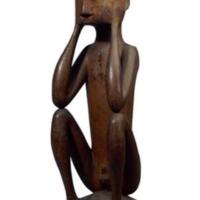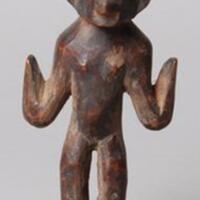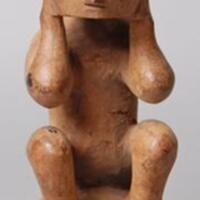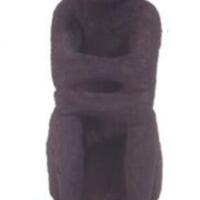Figure
Text
An ivory standing figure of Jesus Christ as Child; figure has been carved in the round with attention to the physiognomy of a toddler, including full cheeks, rolls of fat at the neck, the waist and the ankles; the stomach is rounded, the nipples, navel and genitalia defined; the legs are carved with a slight contrapposto, the left leg proper relaxed (free), while the right leg is engaged taking weight; damage to the feet, both arms are missing, with the stump of a dowel visible on the right shoulder proper; polychromy and traces of gilding. 1600-1650 (circa)
Curators comments:
An Ivory Christ Child of probable Hispano-Philippine/Hispano-Filipino Manufacture. The flattened hair at the crown of the Christ Child suggests that the figure may originally have worn a nimbus, probably of gilt metal. The figure’s right hand is likely to have been raised in blessing, and the figure’s left hand may have supported a staff with pennant, or have been holding an orb. It is likely that this figure once stood atop a pedestal, perhaps fashioned as cushion atop a socle, as we see in figures of the Christ Child raising his hand in blessing by Juan Martinez Montañes, or in so-called Mechelse popjes. Both models are known to have been available in Latin America, and Montañes copy arrived in Ternate the Philippines, from Acapulco, in 1663. Some models of Christ Child standing with hand in blessing appear to relate to the figure known as the Santo Niño de Cebú, the oldest Christian artefact in the Philippines. This Flemish sculpture was taken to the island of Cebu by Ferdinand Magellan in 1521, and recovered from the ruins of the town in 1565 by a mariner involved in the Miguel Lopez de Legazpi expedition. It is unusual for such figures to bear inscriptions, although some items were honoured with filigree metal mounts. This Christ may also have been intended to be dressed, for example, like the Santo Niño de Cebú, either in textile clothes, or garments made of papier-mâché. The detailing of his torso and genitalia does not speak against this, however, it is largely held that separately carved ivory busts, such as the Francis Xavier acquired in 2017, were imágenes de vestir.
Department: Britain, Europe and Prehistory
Share this



